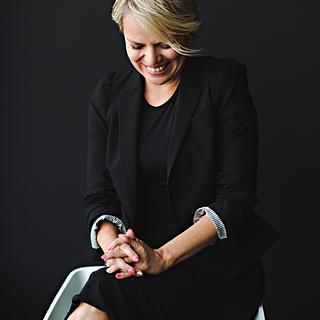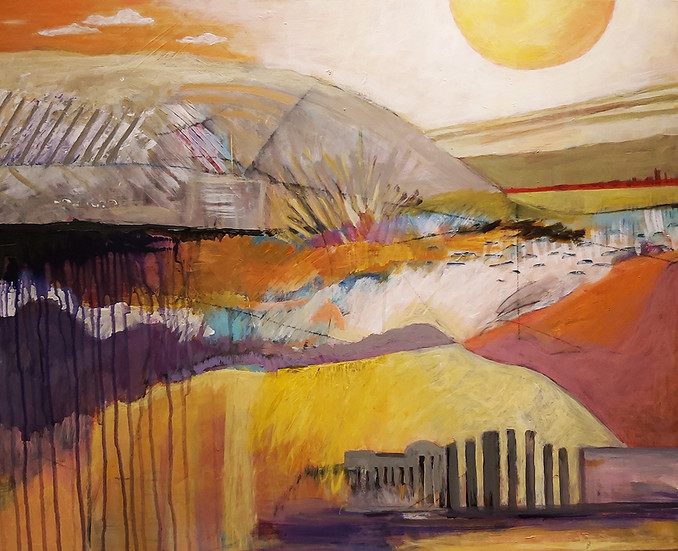Nancy Farrell on finding imagery through layers
- cgoucher
- Sep 14
- 3 min read
Updated: 2 days ago
Nancy Farrell has been painting for decades, but what strikes you most is not the longevity, it is the generosity. She once almost said no when I asked her to teach, but instead she said yes, and that yes changed how I see my own creativity. From clay sculpture to abstraction, Nancy has always trusted the power of marks, drips, and gestures to take on a life of their own.
The first piece of yours I ever saw was that larger-than-life head sculpture, unforgettable in its scale and presence. You’ve since built decades of work in abstraction. Looking back, what first pulled you from sculpture into painting, and when did you realize abstraction was the language you wanted to explore for a lifetime?
I've always liked working with my hands and clay sculpture was available. Turns out there was a clay sculpture group in Guelph where we worked from live models. I have always liked anatomy and enjoyed sculpting a “mood” with clay. I also was taking a few courses in the Fine Art department at the University of Guelph. I liked trying out everything…so did print, drawing and painting. Unfortunately I developed arthritis in my hands which made clay sculpture difficult to continue. So, turned to more painting, taking workshops in order to keep developing my skills. My painting began, like most artists, with realistic figure and landscape. However I was always looking at looser more non-objective abstraction, trying to figure out how to approach a less rigid style. I was lucky to study with Steve Aimone, an artist in the US, whose free-wheeling approach to paint was just what I needed. Abstraction and non-objective painting has remained a challenge which I enjoy.
You often describe beginning a painting with no agenda, just marks, drips, and runs that evolve into balance. Has that process changed over time, or do you find the way you enter a canvas at 86 is still the same as when you were starting out?
I still begin paintings with no specific agenda, although I often pick a palette before I begin, usually no more than 3-4 colours along with black and white. Marks, drips and gestural images are still the way I start.
Abstraction can be misunderstood as random or “easy.” What has been the most enduring challenge of making non-objective work, and has your way of navigating those conversations shifted with experience?
The most enduring challenge is to not overthink and keep those initial marks free and fast. I like strong contrast and keeping the paintings alive and interesting. If the painting starts to look boring, then I go in with more shapes that are completely different. I enjoy experimenting with different colour combinations.
You’ve spent a lot of time in shared creative spaces, from residencies in Florida to studio tours in Guelph, and even those basement classes I was lucky to be part of. How have those kinds of exchanges with other artists (and students) shaped the way you see your own work?
I still like doing workshops, but have not been overly interested in copying someone else’s style; I worked for several years at Neilson Park with John Leonard and enjoyed seeing all the other artists work.
You’ve been known to integrate found materials into your canvases. Has there ever been a moment where an unexpected material or “accident” ended up reshaping a piece in a way you couldn’t have planned?
I don’t find I am adding found materials to my work anymore...just working with paint is challenging enough for me! I am now often focusing on having the work feel like landscape, even though it may not replicate a particular scene. I enjoy making up my own landscape in my own made-up world.
On days when the blank canvas feels daunting, where do you go for that first push, back to nature, to memory, or to something else entirely?
I don’t have any problem in beginning a painting as I know there will be many more marks and shapes to follow in many layers and the imagery will be constantly shifting. I use a variety of tools for my marks…pastel, acrylic, crayon, charcoal, whatever I have around. I do spend time on making sure I have good contrast and always differences in marks and shapes. I wait to see what imagery comes forth. Again I try not to overthink!
You can see more of Nancy’s work at nancyfarrell.com
Know someone creative or curious, or doing something cool in their own way? That’s exactly who I love talking to. I’d love to hear about them or from them.
Did a line or moment from this interview stick with you? Leave a comment, send a message, or tag someone who might want to be part of this series. You never know whose story will show up next. I read every one.














